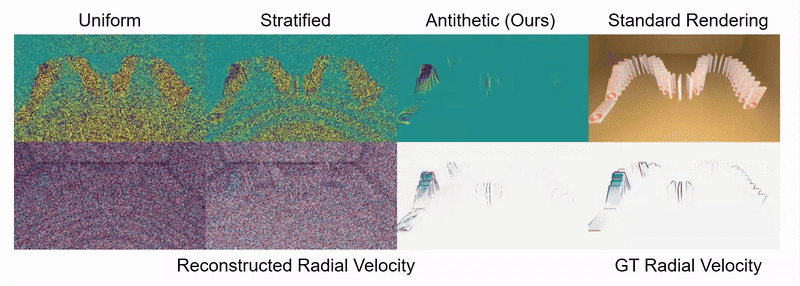This repository is the official Mitsuba3 implementation of "Doppler Time-of-Flight Rendering" by Juhyeon Kim, Wojciech Jarosz, Ioannis Gkioulekas, Adithya Pediredla (SIGGRAPH Asia 2023, journal paper). Please also check Mitsuba0.6 implementation at here.
To compile, follow the original Mitsuba3's compliation guide at here.
Our implementation only works on CUDA and llvm, so make sure to include CUDA or llvm as a backend in mistuba.conf.
We recommend to include cuda_rgb configuration.
(20240707 added) If following error occurs, please refer to this link here.
COMPILE ERROR: Invalid PTX input: ptx2llvm-module-001: error: Failed to parse input PTX string
ptx2llvm-module-001, line 2; fatal : Unsupported .target 'sm_87'
Cannot parse input PTX string
New integrator named dopplertofpath is added for Doppler ToF rendering.
Followings are explanation for each parameter.
-
time: Exposure time in sec. (default : 0.0015)- Because of precision issue, the output image is divided by the amount of the
time. You should multiplytimeto get a correct result.
- Because of precision issue, the output image is divided by the amount of the
-
w_g: Illumination modulation frequency in MHz. (default : 30) -
g_1: Illumination modulation scale. (default : 0.5) -
g_0: Illumination modulation offset. (default : 0.5) -
w_s: Sensor modulation frequency in MHz. (default : 30) -
sensor_phase_offset: Sensor phase offset in radian. (default : 0) -
We also provide some syntactic sugar parameters with normalization.
hetero_frequency: Relative heterodyne frequency. 0 for perfect homodyne and 1 for perfect heterodyne. This is a syntactic sugar forw_s. If this value is set,w_sis calculated from this value. (default : not used)hetero_offset: Relative heterodyne offset. 0 for 0 radian and 1 for 2pi radian. This is a syntactic sugar forsensor_phase_offset. If this value is set,sensor_phase_offsetis calculated from this value. (default : not used)
-
wave_function_type: Modulation waveform. Refer following table for exact configuration. (default : sinusoidal)
wave_function_type |
Sensor Modulation | Light Modulation | Low Pass Filtered |
|---|---|---|---|
sinusoidal |
sinusoidal | sinusoidal | sinusoidal |
rectangular |
rectangular | rectangular | triangular |
triangular |
triangular | triangular | Corr(tri, tri) |
trapezoidal |
trapezoidal | delta | trapezoidal |
low_frequency_component_only: Whether to use low pass filtering for modulation functions. (default : true)
-
time_sampling_method: Times sampling method.uniform: uniform samplingstratified: stratified samplingantithetic: shifted antithetic samplingantithetic_mirror: mirrored antithetic sampling
-
antithetic_shift: User defined antithetic shift. (default : 0.5 forantithetic, 0.0 forantithetic_mirror)
Unlike Mitsuba0.6, we only support sampler-level correlation (temporal random replay).
This exploits the advantage of parallelization at the most.
In other words, we do not explicitly correlate ray-by-ray fashion. (e.g ray_position or ray_sampler in Mitsuba0.6 version)
We are planning to add this implementation in future.
We implemented path correlation with custom repeated sampler, so use correlated sampler in all cases.
Followings are parameters used in correlated sampler.
time_correlate_number: The number of correlated time random generator. (default : 2)path_correlate_number: The number of correlated path random generator. (default :time_correlate_number)use_stratified_sampling_for_each_interval: Whether to use full stratification over time. If set totrue, it works differently bytime_sampling_mode. (default : true)stratified: correlated randomly over different stratum (Fig.8-(6a) in the main paper)antithetic: use stratification for primal sample (Fig.8-(7a) in the main paper)antithetic_mirror: use stratification for primal sample (Fig.8-(8a) in the main paper)
Note that correlated sampler generate repeated random numbers, and time_sampling_method and antithetic_shift actually decide how to transform this into specific time samples.
To simulate Doppler ToF rendering, we implemented motion blur which is not implemented in original Mitsuba3.
We exploit OptiX motion blur functionalities for implementation.
The default Mitsuba3 interpolation on transformation matrix seems to be inaccurate, we used a simple linear interpolation (check transform.h line 466).
For scene formatting, we tried to be similar with Mitsuba0.6 version.
cd configs_example
mitsuba scene.xml -m cuda_rgb
We also included exhaustive examples in doppler_tutorials folder at here.
You can simulate various experiments in the main paper.
If you find this useful for your research, please consider to cite:
@article{kim2023doppler,
title={Doppler Time-of-Flight Rendering},
author={Kim, Juhyeon and Jarosz, Wojciech and Gkioulekas, Ioannis and Pediredla, Adithya},
journal={ACM Transactions on Graphics (TOG)},
volume={42},
number={6},
pages={1--18},
year={2023},
publisher={ACM New York, NY, USA}
}
